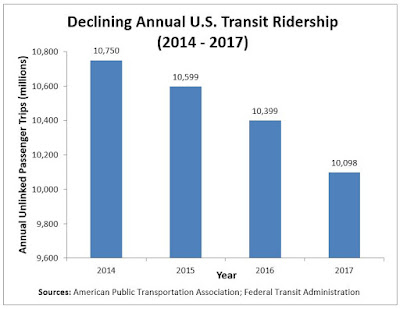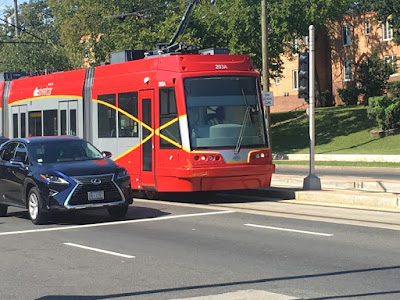Transit ridership fell in 31 of 35 major metropolitan areas in the United States last year, including the seven cities that serve the majority of riders, with losses largely stemming from buses but punctuated by reliability issues on systems such as Metro, according to an annual overview of public transit usage. (WP, 3/24/18)
 |
| US Transit Ridership decline 2014-17 (APTA) |
Boy, have times changed since 1976! The Great Society" largess wasn't sustained when Nixon, Ford and eventually Reagan recasted government as a necessary evil that has to be shrunk not as something that should strive for excellence. The dominance of cars has continued and transit ridership of the fabled DC Metro system has fallen into such disrepair that it was plagued by shutdowns in 2017. The much loved transportation network systems (TNCs) such as Uber and Lyft have taken a bite out of transit instead of being the hoped for "last mile" solution.
Transit aspirations shrank with the budgets and the ridership. Instead of building real subways, cities asked themselves: how about light rail? Near the turn of the century half a dozen pioneer cities brought a beefed up streetcar back, decades after the legacy streetcars had been thrown under the bus. Literally. In 1992 Baltimore was once again a transit leader and among the cities pioneering light rail, along with Portland, Sacramento, San Diego, Denver and Dallas. Pittsburgh transformed its still active legacy streetcars into a light rail system with downtown tunnels, something that Boston and Philly had done for a long time.The dumbing down of transit
The Capital Metro, "The Great Society Subway" (Photo: NYT, Zach Gibson)
 |
| Baltimore Metro |
 |
| DC Streetcar: One line and no more (Photo: Philipsen) |
 |
| Los Angeles Metro Rapid Bus |
 |
| Cleveland BRT: Health Line |
By now, even the watered down US version of BRT running in its own right of way, has been dumbed down further to some type of limited bus that is made to be just a bit faster than the standard bus by skipping a few stops. In most cities this incarnation of bus service is called "Rapid"and where it overlays existing local bus service, it can be quite effective, such as in Los Angeles. In Baltimore this.
A new view of transit: Access
Baltimore bus overhaul: New bus colors-continued bunching (Photo: Philipsen) None of these ever cheaper transit modes are inherently bad or unworkable as long as they are not meant to substitute for the bigger solutions. Some cities defied the downward spiral towards the lowest common denominator and still build rail in all its variations: As heavy-rail subway, most aggressively: LA, most expensively: New York. As light rail as in Denver, Seattle and Minneapolis, or, in spite of all the spite, as streetcar (Atlanta). Yet, for most large US cities the regular bus remains as the transit backbone, all shortcomings not withstanding.
As progressive transit experts will point out, a discussion of transit that is solely focused on mode is outmoded and irrelevant. They argue that it doesn't matter what gets you there, as long as you get where you want to go within a reasonable time. This outcome based view replaces the traditional services based approach and constitutes an entirely new mindset with a new set of vocabulary.
In the cotest with the automobile the mantra of moving people instead of cars and mobility had long become transit's holy grail, but the the latest outcome based buzzword is access. With access as the lens, transit has been discovered as the key to all kinds of success, including equity, economic development and even health. Transit provides access to jobs, to education, to affordable housing and health care for anyone who doesn't have other mobility choices. Increasingly, access through other means than the single occupant cars is a desiderable outcome by vastly larger population segments than the urban poor.
One could say that while investment in transit has been systematically driven down, the importance attributed to transit as a key to metropolitan prosperity has increased. There can't be much dispute, that transit is key for equitable or sustainable access, especially in large metropolitan areas. Nor can there be much dispute that access is a good metric.
Unfortunately, access proves to be a particularly tricky beast, because its many facets and variables. Trips today are increasingly dispersed far beyond the relatively easy to describe trip between home and work. The majority of rides today serve all kinds of other purposes. Trying to optimize an entire urban transit system for access requires an excessively complex modeling. For a model to reliably simulate all the different types of access for all the relevant origins and destinations in a city is a task that has not yet been convincingly mastered, in spite of powerful tools and significant progress. For Maryland's new Purple Line circumferential light rail line, for example, the National Center for Smart Growth at the University of Maryland created heat maps showing the geographic areas accessible via transit within 30 minutes and an hour. The maps were generated for each suggested station, comparing access with and without the new line.
In Baltimore, for example, three modes of rail move about 130,000 riders a day; some 750 buses, by contrast, move a quarter million people daily. Many cities, comparable to Baltimore, don't even have any rail, all transit there happens by bus. Bus advocates contend that the bus can become much more than a loud vehicles which emits fumes and is stuck in all the other traffic and is the last resort for those who can't use a car. Buses have some kind of renaissance buoyed by new technologies such as clean diesel, hybrid motors, GPS, level boarding, large windows, real time bus arrival signs, fully electric propulsion, cashless ticketing and, at times, longer, double articulated vehicles.
Purple line heat maps of access with and without the new transit line (NCSG)
Proponents of bus overhauls such as bus guru Jarret Walker would say, that the focus on the bus isn't simply a trick to save money but a legitimate response to the demand for access, given the reality that in most US cities the bus moves a lot more people than rail.
The focus on access goes beyond the bus. The access lens brings into view everything that can be used to get from the origin to the destination, including walking, bike-share, car-share, demand-based van shuttles, personal pods and micro transit. Even electric scooters are discussed as tools to cover the "last mile", although, even the biggest scooter enthusiasts would have to admit that they mostly cater to a very narrow demographic of the young, fit and fearless.
The multimodal access discussion of today with its cheap for-profit components is the dream of all those who want to do transit for less (public) money. However, for those active modes to really work, infrastructure investments into accessible sidewalks systems, protected bike lanes and safre complete streets are still imperative. There is no free lunch. No last mile share network, no fancy bus technology and no dedicated bus lane will make the original Great Society impulse wrong which assumed that for a larger city it takes trains to move massive amounts of people rapidly and comfortably.
The nation's Capital, which long has been smaller than neighboring Baltimore proves this point. Its Great Society subway which continued to grow enabled the city to grow and prosper as well, to a point that riders are now overwhelming the system. Lack of funding for maintenance made it loose some of its luster, in spite of its initial aspirations and the architecturally interesting large stations. By contrast, Baltimore has a much harder time to stage its own renaissance. With the help of the DC subway, DC's population now exceeds that of Baltimore, the greater Washington metro area has now double the size of the Baltimore region. Not only the city proper but also the surrounding suburban rings boast a good number of successfully transformed urban centers which can rightly be called transit oriented development.
Land Use
Instead of Whiteflint Mall as mixed use TOD: Rose&Pine (Philipsen)
This brings into view another aspect of great importance to effective access and transit: land use! Land use remains insufficiently discussed and considered when it comes to solving transportation problems or the reduction of single occupancy vehicle traffic. Transit cannot and should not chase every job that has sprawled far into the periphery of our urban conglomerations. Neither can transit, not even bus transit, serve sprawling large lot single family-home developments effectively. More concentrated land use patterns are actually more effective in providing access than any transit system can be, simply by putting origins and destinations much closer together. Unfortunately, transit and land use are not only not handled in the same departments but frequently also not even in the same jurisdiction. While it is obvious that transportation needs a regional perspective, the same is not clear to those who defend the typically local and myopic US land use autonomy which all too often pays no attention to transportation or other regional infrastructure impacts.Funding
Multimodel transportation systems: Milanamos
Ultimately, attempts to solve access with seamless multimodal journeys cannot succeed without public investment into high capacity transit. There is no real competition to rail in large population centers, no matter how well the buses run. Bus and rail are not alternatives, but complementary solutions in metropolitan transportation. The feds and in many cases the states collect by far the largest share of taxes; they need to continue to invest big into transit.
Private public partnerships in private design-build-operate models can be no substitute for that, all they do is defer cost to future generations plus a substantial up-charge. Regarding private capital, much more promising than using private companies as banks to fund transit, is capture of the value which transit creates for real estate. Value capture from developments in transit corridors through special assessment districts, or preferably, through financial tools such as TIFs can leverage not only capital for operation but also for the initial construction without kicking the cost simply down the road, they would allow real investments into a livable future.
Klaus Philipsen, FAIA
Value Capture















No comments:
Post a Comment